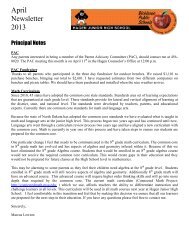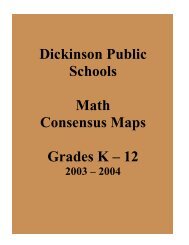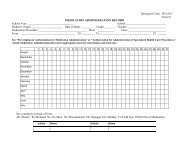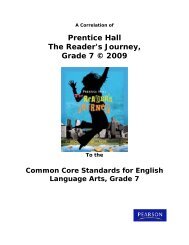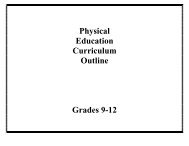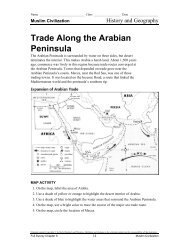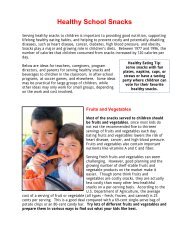Dickinson High School Program Improvement Plan
Dickinson High School Program Improvement Plan
Dickinson High School Program Improvement Plan
Create successful ePaper yourself
Turn your PDF publications into a flip-book with our unique Google optimized e-Paper software.
<strong>Dickinson</strong> <strong>High</strong> <strong>School</strong> <strong>Program</strong> <strong>Improvement</strong> <strong>Plan</strong><br />
<strong>Dickinson</strong> <strong>High</strong> <strong>School</strong> serves approximately 735 students in grades 9-12 (May 2012 enrollment).<br />
Currently we have 60 teachers which include three counselors. We have a number of teachers with<br />
master degrees with the majority of teachers having many credits beyond their bachelor’s degree.<br />
Reading and math are the areas in which <strong>Dickinson</strong> <strong>High</strong> did not make Adequate Yearly Progress. Our<br />
building goal (see attachment) is to have 85% or more of all students in each departmental course<br />
offering perform at a C level or higher. Special emphasis is being placed on reading and math. A math<br />
action plan (see attachment) was developed four years ago to address some of our math weaknesses.<br />
As an entire faculty, we are working on strategies for improving our reading and writing skills of<br />
<strong>Dickinson</strong> <strong>High</strong> students. The language arts department is helping spearhead this work. The following<br />
are the things we have specifically done this past year to help improve reading and writing:<br />
<br />
<br />
<br />
<br />
<br />
<br />
Book study by some teachers on ReLeah Lent’s book Literacy for Real—Reading, Thinking, and<br />
Learning in the Content Areas.<br />
Professional Development for teachers in grades 7-12 during the April 20, 2012 Reading<br />
Conference in <strong>Dickinson</strong>. This professional development was led by author ReLeah Lent.<br />
Reading/Writing Committee made up of members from the core classes. This committee<br />
worked on developing strategies building wide for improving reading and writing. One example<br />
was a common rubric for identifying key writing areas when students are answering essay<br />
questions.<br />
Beginning the use of mastery manager to help teachers through common assessments identify<br />
key areas that need improvement.<br />
A writing workshop (to help improve writing skills) was held at least three times a week during<br />
Opportunity Period and the lunch hour.<br />
Students in grade 9 who were reading significantly below grade level were placed in an intensive<br />
reading intervention program using Read 180 and System 44.<br />
<strong>Plan</strong>s for the 2012-2013 school year are as follows:<br />
<br />
<br />
<br />
August 20, 2012 Dr. Chris Weber from Solution Tree will work with teachers and administrators<br />
to help focus our efforts during teaming time. He will also speak about the connection of RtI<br />
and RtI-B.<br />
Ongoing teaming/collaboration time each week during the contract day. These discussions will<br />
focus on student learning by identifying student learning targets, developing common formative<br />
assessments, analyzing student work, and planning for effective instruction, intervention and<br />
enrichment. The mastery manager program will also be used to analyze the common<br />
assessments.<br />
More book studies on reading/writing and possibly the common core standards.
Continue and possibly expand the number of students who will use the READ 180 program.<br />
Early Release Days (Oct. 31, Dec. 12, Feb. 27, April 10) and Professional Development Days on<br />
Sept. 24 and Jan. 21) will be used to continue developing building wide strategies for improving<br />
reading/writing.<br />
<strong>School</strong> Leadership team will continue to meet two or three times a month with one of the<br />
priorities being to develop building wide interventions to be used during Opportunity Time.<br />
The Language Arts Department will begin meeting this fall to review course offerings in the area<br />
of reading and writing. The first step will be to review the freshmen grammar and literature<br />
classes.<br />
We are using the following to inform instruction at the high school level:<br />
<br />
<br />
<br />
<br />
<br />
<br />
<br />
Standards have been and will continue to be reviewed by teachers<br />
Text book assessments<br />
MAP scores in Language Arts, Reading, and Math<br />
NDSA scores in Language Arts, Reading, Math, and Science<br />
ACT scores—composite scores and scores in Language Arts, Math, Science<br />
Common formative assessments<br />
Begin to do a better job of horizontal and vertical discussions between teachers and<br />
departments to better align standards and instruction<br />
The next important step for DHS is creating an individual growth plan for all students who have not met<br />
achievement expectations on the state assessment. The following are some of the things we will be<br />
using to create such a plan for students:<br />
<br />
<br />
<br />
<br />
<br />
<br />
Measures of Academic Progress (MAP) are assessments that are taken by <strong>Dickinson</strong> <strong>High</strong><br />
students in grades 9 and 10. Student’s academic progress is measured in reading and math<br />
along a continuous scale. Growth can be measured from year to year. These assessments give<br />
us excellent information in regard to which students are struggling in these areas. We have also<br />
found out that the majority of the time these MAP assessments correlate very closely to<br />
previous state assessment tests taken by the students.<br />
We will also try and use the “short survey” MAP assessment. This will be used for new students<br />
to give us a better and quicker understanding of their strengths and weaknesses.<br />
Opportunity Period documentation will also be used to identify students and their weaknesses.<br />
Data gathered using Viewpoint will be used to assess the student’s weaknesses.<br />
Common formative assessments by teachers with Mastery Manager breaking down the data to<br />
give us more information about which students are struggling and in what areas.<br />
Using the above methods to gather data about at risk students, we will then identify<br />
interventions to be used to help each student individually with their weaknesses. These<br />
interventions could be things such as READ 180 class, Tier 2 interventions during Opportunity<br />
Period, one on one tutoring, schedule changes, Individualized Reading class, paraprofessional<br />
support, etc.
For the most part, I have concentrated on what we are doing and what we are going to do to help<br />
improve our student’s expertise in reading and writing. The following is <strong>Dickinson</strong> <strong>High</strong>’s <strong>School</strong><br />
<strong>Improvement</strong> Goals for 2012-2013, and Adequate Yearly Progress (AYP) and Math Action <strong>Plan</strong>. Attached<br />
with this document is our SMART Goal Action <strong>Plan</strong> for 2012-2013 and data on AYP from 2009 – 2012.<br />
<br />
<br />
<br />
Each department, by course, will determine a<br />
percentage for their content area, requiring at<br />
least the minimum of 85%.<br />
Phase 1 (What should all students know)<br />
<br />
<br />
Review power benchmarks<br />
Develop student-friendly “I-can”<br />
statements<br />
Phase 2 (How will we know when students<br />
have learned)<br />
85% or more of all<br />
students in each<br />
departmental course<br />
offering will perform at C<br />
level or higher.<br />
<br />
<br />
<br />
Develop common formative and<br />
summative assessments<br />
Use of NWEA tests for assessment<br />
Standards-based report cards (pilot<br />
program starting January 2013)<br />
<br />
Phase 3 (How will we respond when students<br />
don’t learn)<br />
<br />
<br />
<br />
<br />
<br />
RTI/Pyramid of Interventions<br />
Opportunity Period<br />
Tier II and III Interventions<br />
Differentiating, flexible grouping, …<br />
Parental Involvement<br />
<br />
Phase 4 (How will we respond when students<br />
learn ahead of their peers or already know<br />
what we are teaching)<br />
<br />
Use of RTI time for advanced learning
Math Action <strong>Plan</strong><br />
1) The yearlong algebra I class will be taught; teachers will keep the same students for the entire<br />
year. Entry level courses such as this one and basic geometry will focus on the power standards.<br />
We will use the math teacher’s areas of expertise in determining staffing assignments.<br />
2) State assessment tests will be administered by the math teachers and the math portion will be<br />
the first test given to students.<br />
3) The <strong>School</strong> Board has added an additional half time math teacher. This will allow smaller class<br />
sizes in the year long algebra class. Class size is estimated at 17 students which is approximately<br />
5-6 fewer students per section as this year.<br />
4) NWEA tests will be used to assess math students throughout the school year due to the close<br />
correlation with the state assessment test. Information gathered from these tests will be used<br />
by teachers to adjust instruction where needed. Students requiring intervention help will be<br />
identified and extra instruction will be given by math teachers.<br />
5) Extra time in math classes will be taken to review areas of weakness identified by past state<br />
assessment tests.<br />
6) Professional development will increase for teachers in grades 7-12 and more collaboration time<br />
will be provided for the math instructors. The professional development will help teachers<br />
develop strategies and techniques to better meet the needs of today’s students.<br />
7) <strong>Dickinson</strong> <strong>High</strong>’s <strong>School</strong> <strong>Improvement</strong> <strong>Plan</strong> in regard to math will be this action plan. This will be<br />
facilitated by the <strong>Dickinson</strong> <strong>High</strong> <strong>School</strong> principal. Data for this plan will begin to be gathered<br />
beginning in the 2008-09 school year.



